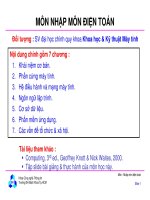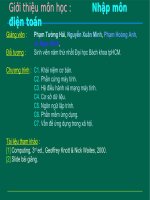The system unit (NHẬP môn điện TOÁN SLIDE)
Bạn đang xem bản rút gọn của tài liệu. Xem và tải ngay bản đầy đủ của tài liệu tại đây (930.97 KB, 32 trang )
Chapter 06: The System
Unit
© 2012 The McGraw-Hill Companies, Inc. All rights
reserved.
Computing Essentials 2012: Making IT Work for You
Competencies
(1 of 2)
• Describe the six basic types of system units
• Discuss how a computer can represent
numbers and encode characters
electronically
• Describe each of the major system unit
components
• Discuss microprocessors,
including microprocessor
chips and specialty processors
• Discuss memory including
RAM, ROM, and flash memory
© 2012 The McGraw-Hill Companies, Inc. All rights
reserved.
6-2
Computing Essentials 2012: Making IT Work for You
Competencies
(2 of 2)
• Discuss expansion slots
and cards
• Describe five principal
types of expansion buses
• Compare standard,
specialized, and legacy
ports
ã Discuss power supply for
desktop and notebook
computers
â 2012 The McGraw-Hill Companies, Inc. All rights
reserved.
6-3
Computing Essentials 2012: Making IT Work for You
Introduction
• Speed, capacity, and flexibility determine
the power of microcomputers.
• Knowledge of a computer’s power allows
you to make good buying decisions and
to determine if your current system will
run new applications.
• Competent end users need to
understand the basic principles
of how microcomputers are
put together.
© 2012 The McGraw-Hill Companies, Inc. All rights
reserved.
6-4
Computing Essentials 2012: Making IT Work for You
System Unit Types
•
•
•
•
•
•
Desktop System Units
Media Center System Units
Notebook System Units
Tablet PC System Units
Handheld Computer
System Units
© 2012 The McGraw-Hill Companies, Inc. All rights
reserved.
6-5
Computing Essentials 2012: Making IT Work for You
System Unit
System Chassis, System
Board (Motherboard),
Microprocessor, Memory,
Socket, Bus Lines, and
Expansion Slots
© 2012 The McGraw-Hill Companies, Inc. All rights
reserved.
6-6
Computing Essentials 2012: Making IT Work for You
Electronic Data and
Instructions
• Data and instructions are represented
electronically
• Two-state system or Binary System
– Off/On electrical states
– Characters represented by 0’s (off) and
1’s (on)
– Bits
– Bytes
© 2012 The McGraw-Hill Companies, Inc. All rights
reserved.
6-7
Computing Essentials 2012: Making IT Work for You
Character Coding
Schemes
• Three
types of binary
coding schemes
– ASCII - American
Standard Code for
Information Exchange
– EBCDIC - Extended
Binary Coded Decimal
Interchange Code
– Unicode - handles
languages with large
numbers of characters
© 2012 The McGraw-Hill Companies, Inc. All rights
reserved.
6-8
Computing Essentials 2012: Making IT Work for You
System Board
• Connects all components
• Allows communication between
devices
• Main board or
motherboard
• Circuit board
components
– Sockets
– Slots
– Bus lines
© 2012 The McGraw-Hill Companies, Inc. All rights
reserved.
6-9
Computing Essentials 2012: Making IT Work for You
Microprocessor Chips
• Central Processing Unit (CPU)
– Measurement units for processing speed
(shown here)
• Two Basic Components
– Control unit
– Arithmetic-logic unit (ALU)
© 2012 The McGraw-Hill Companies, Inc. All rights
reserved.
6-10
Computing Essentials 2012: Making IT Work for You
Microprocessor Chips
• Chip capacities are expressed in word
sizes
• Two significant developments
– 64-bit processors
• Have become standard for most of
today’s desktop and laptop computers
– Multi-Core Chips
ã Can provide two
separate and
independent CPUs
ã Parallel Processing
â 2012 The McGraw-Hill Companies, Inc. All rights
reserved.
6-11
Computing Essentials 2012: Making IT Work for You
Specialty Processors
• Coprocessors
– Designed to improve specific computing
operations
– Graphics coprocessors
• Smart cards
– Credit card sized with an embedded chip
– Used by many universities
• Specialty processors in cars
– As many as 70
– Used to control features
ã RFID tags
Information chips
Used for tracking purposes
â 2012 The McGraw-Hill Companies, Inc. All rights
reserved.
6-12
Computing Essentials 2012: Making IT Work for You
Memory
• Holding area for data, instructions,
and information
• Memory is contained on chips
connected to the system board
• Types of memory chips
–
–
–
RAM – Programs and data
ROM – Fixed start-up instructions
Flash – Flexible start-up instructions
© 2012 The McGraw-Hill Companies, Inc. All rights
reserved.
6-13
Computing Essentials 2012: Making IT Work for You
RAM
• Random Access Memory (RAM) chips
hold the program and data
– Cache memory or RAM cache
– Flash RAM or flash memory
• Other types of RAM
–
–
–
–
DRAM
SDRAM
DDR
Direct RDRAM
Return
© 2012 The McGraw-Hill Companies, Inc. All rights
reserved.
6-14
Computing Essentials 2012: Making IT Work for You
ROM
• Read-only memory (ROM) chips are
not volatile and cannot be changed by
the user
• CPU can read, or retrieve data and
programs but the computer cannot
write
• Contain special instructions
– Needed to start a computer
– Give keyboard keys their special
capabilities
– Put characters on screen
© 2012 The McGraw-Hill Companies, Inc. All rights
reserved.
Return
6-15
Computing Essentials 2012: Making IT Work for You
Flash
• Flash memory offers a combination of
the features of RAM and ROM.
• Flash memory is used for a wide of
range of applications.
• If changes are made to the computer
system, these changes are reflected
in flash memory.
Return
© 2012 The McGraw-Hill Companies, Inc. All rights
reserved.
6-16
Computing Essentials 2012: Making IT Work for You
Expansion Slots and
Cards
• Allows
for new devices
to be added
– Open architecture
– Slots provide for expansion
ã Expansion cards
are also called
Plug-in boards
Controller cards
Adapter cards
Interface cards
â 2012 The McGraw-Hill Companies, Inc. All rights
reserved.
6-17
Computing Essentials 2012: Making IT Work for You
•
•
•
Commonly Used Expansion
Cards
Graphics cards
Sound cards
Network interface cards
(NIC)
• Wireless network cards
• PC cards & Express cards
ã TV tuner cards
â 2012 The McGraw-Hill Companies, Inc. All rights
reserved.
6-18
Computing Essentials 2012: Making IT Work for You
TV Tuner Cards And
Video Clips
• Allows you to view your favorite TV
shows while running other
applications such as Excel
• Video can be captured to a file, added
to a Web page, attached to an email,
or added to a class presentation
ã Inexpensive and
easy to install
â 2012 The McGraw-Hill Companies, Inc. All rights
reserved.
6-19
Computing Essentials 2012: Making IT Work for You
Plug
and Play
• Set
of specific hardware and software
standards developed by Intel,
Microsoft, and others
• Creating devices that are able to
configure themselves when installed
© 2012 The McGraw-Hill Companies, Inc. All rights
reserved.
6-20
Computing Essentials 2012: Making IT Work for You
Bus Lines
• Connect parts of the CPU to each
other
• Data roadway for traveling bits
– Measured as bus width
– More lanes, faster traffic
• Two basic categories
– System buses
– Expansion buses
© 2012 The McGraw-Hill Companies, Inc. All rights
reserved.
6-21
Computing Essentials 2012: Making IT Work for You
Expansion Buses
• Connects the CPU to other
components on the system board,
including expansion slots
• Principal types
–
–
–
–
Peripheral Component Interconnect (PCI)
Universal serial bus (USB)
FireWire buses
Serial Advanced Technology Attachment
(SATA)
– PCI Express (PCIe)
© 2012 The McGraw-Hill Companies, Inc. All rights
reserved.
6-22
Computing Essentials 2012: Making IT Work for You
Ports
• Socket for connecting external
devices
• Ports can connect directly to the
system board or they can connect to
cards that are inserted into slots on
the system board
ã Three Types
Standard Ports
Legacy Ports
Specialized Ports
â 2012 The McGraw-Hill Companies, Inc. All rights
reserved.
6-23
Computing Essentials 2012: Making IT Work for You
Standard Ports
• Four common ports
–
–
–
–
VGA
USB ports
FireWire ports
Ethernet ports
Return
© 2012 The McGraw-Hill Companies, Inc. All rights
reserved.
6-24
Computing Essentials 2012: Making IT Work for You
Legacy Ports
•
•
•
Serial ports
Parallel ports
Keyboard and mouse ports
ã Infrared data association (IrDA)
ã Game ports
Return
â 2012 The McGraw-Hill Companies, Inc. All rights
reserved.
6-25









